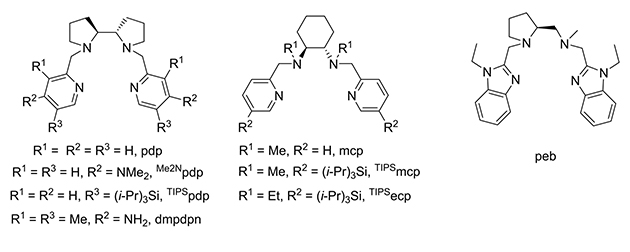Abstract
A family of manganese complexes [Mn((R)peb)(OTf)(2)] (peb=1-(1-ethyl-1H-benzo[d]imidazol-2-yl)-N-((1-((1-ethyl-1H-benzo[d]imidazol-2-yl)methyl) pyrrolidin-2-yl)methyl)-N-methylmethanamine)) derived from L-proline has been synthesized and characterized, where R refers to the group at the diamine backbone. X-ray crystallographic analyses indicate that all the manganese complexes [Mn((R)peb)(OTf)(2)] exhibit cis-alpha topology. These types of complexes are shown to catalyze the asymmetric epoxidation of olefins employing H2O2 as a terminal oxidant with up to 96% ee. Obviously, the R group of the diamine backbone can influence the catalytic activity and enantioselectivity in the asymmetric epoxidation of olefins. In particular, Mn((i-Pr)peb)(OTf)(2) bearing an isopropyl arm, cannot catalyze the epoxidation reaction with H2O2 as the oxidant. However, when PhI(OAc)(2) is used as the oxidant instead, all the manganese complexes including Mn((i-Pr)peb)(OTf)(2) can promote the epoxidation reactions efficiently. Taken together, these results indicate that isopropyl substitution on the (R)peb ligand inhibits the formation of active Mn(V)-oxo species in the H2O2/carboxylic acid system via an acid-assisted pathway.

Keywords Plus:NONHEME IRON-CATALYSTSC-H OXIDATIONSENANTIOSELECTIVE EPOXIDATIONH2O2CARFILZOMIBOXIDANTSINSIGHTSKETONESFE
Published in ADVANCED SYNTHESIS & CATALYSIS;10.1002/adsc.202101151,NOV 2021


